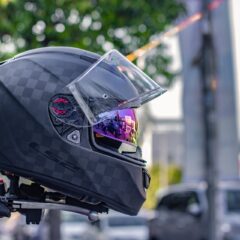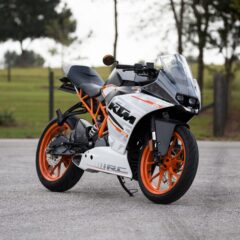
7 Top Motorcycle Accessories
With Christmas just around the corner, you might be wondering what to get your favourite motorcycle enthusiast or even a little something for yoursel...
 Phoenix Motorcycle Training LTD
Phoenix Motorcycle Training LTD
 Phoenix Motorcycle Training LTD
Phoenix Motorcycle Training LTD

Motorcycle helmets are a vital part of motorcycle safety. Wearing one is compulsory in the UK if you’re riding on the road. Any pillion passengers you take on your motorcycle will need to wear a helmet too. Because there are so many different motorcycle helmet types, it’s important to choose one that suits your riding conditions and style.
While a motocross or trail riding helmet maybe legal to use on UK roads, it’ not necessarily the best choice. Each of the motorcycle helmet types comes with its own pros and cons. In this blog post, we will discuss the different types of motorcycle helmets available in the UK, what makes them unique and how to choose the best one for you.
The law says you must wear a motorcycle helmet when riding on UK roads including the chin strap has to be done up under your chin and there’s a dizzying array of motorcycle helmet types available. They’re one of the most expensive pieces of kit you need, so it pays to do a little research before you buy one. Although motorcycle helmet types can be broken into three main categories, there are several different kinds to choose from.
Full-face helmets are one of the most popular motorcycle helmet types in the UK. They offer maximum protection for riders and cover the entire head, including the chin and face areas. Full-face helmets also usually have a built-in visor which offers sun protection from harmful UV rays as well as eye protection from debris on the road surface such as stones or insects. Full-face helmets are a great option for riders travelling at higher speeds or in areas with more traffic.
Open-face or 3/4 helmets cover the top, back, and sides of your head but leave your face exposed. They provide less protection than other helmet types because they leave these parts of the face exposed. However, they provide more ventilation and let riders communicate easily with other motorcyclists as well as people they pass while riding.
The main disadvantage of open-face helmets is the lower level of protection for collisions at high speeds. They also can be noisy because of the lack of a chin bar and sealed visor which can be distracting when riding.
Modular helmets are a hybrid between full-face and open-face designs. A hinge around the side jaw section of the helmet lets you flip up your visor without having to remove your helmet entirely to speak or eat. This is great for riders who need frequent communication with other motorists or pedestrians.
The protection of a modular helmet is better than an open-faced helmet, but not quite so good as a single-piece, full-face helmet. They also tend to be heavier than full-face designs due to their additional moving parts which can make them uncomfortable after long rides
Of course, there are variations on the above motorcycle helmet types too. Motocross helmets have been designed for off-road riding, but are still legal on UK roads. Then, of course, you have smart helmets that do a whole lot more than protect your head and eyes while riding.
Easily spotted by the elongated chin area and visorless face section, an off-road helmet provides a similar level of protection as a full-face motorcycle helmet. The shape provides more ventilation than the usual full-face helmet and when paired with a set of goggles you’ll get UV sun and bug protection for your eyes too.
The downside of using these for riding on the road is they tend to have less insulation. That can make riding in cooler temperatures on a commute a little uncomfortable. Obviously, you’ll need to stump up for goggles to go with the helmet too.
Designed to be the best of both worlds, dual sports helmets are made for road motorcycling and off-roading. You’ll notice the chin area isn’t quite as elongated as off-road helmets, but there’s a big vent at the front to keep air flowing freely. The visor area tends to be a bit wider than the typical full-face motorcycle helmet types too, which increases visibility. That’s always a good thing.
These helmets have more insulation than their off-road counterparts which makes them a little quieter and warmer on the road. It doesn’t impair the off-road functionality either, so you really do get the best of both worlds with these helmets. One downside can be the cost, dual sports helmets are one of the more expensive options.
Smart motorcycle helmets are relatively new to the UK and come equipped with sensors and other technologies to keep motorcycle riders safe and connected. Many smart motorcycle helmets link up to smartphones and feature head-up displays (HUD) for easy access to navigation and entertainment features. Some are Bluetooth enabled so you can listen to music, chat with other bikers and take calls on the road!
You could consider these advanced features as benefits or as distractions. Smart motorcycle helmets are becoming more popular but they come with a hefty price tag that you may or may not think is justified after taking it for a ride.
Once you’ve decided on which lid is likely to be best for you, it’s time to go out and try a few on. What sounds great in print might not feel so great when it’s on your head. Be prepared to shop around a little and don’t rush. Sharp’s helmet safety scheme also offers some great advice and provides safety ratings for lids sold in the UK.
Aim to get the helmet in your price range with the highest Sharp safety rating possible. We’ve also noted a few pointers below to demystify motorcycle helmet shopping.
So how do you know a helmet fits? At first, a helmet feels a bit strange on your head. There are a few things to look out for so you know if it’s the right choice for you.
You should be able to feel the inside pads firmly against your forehead, cheeks and temples, without it being tight. It should be snug around the back of your head too with no room for sliding fingers in between your skull and the inside of the helmet.
You’ll want minimal movement – no twisting around if you turn your head and minimal back-and-forth movement. Your eyes need to be central to the top of the face opening. If the helmet is touching your eyebrows, it’s too big, halfway up your forehead means it’s too small.
It should go without saying that the helmet shouldn’t come off your head when you shake it. That goes for any of the motorcycle helmet types you try.
You’ll need to choose your motorcycle helmet type when you first start riding on the road. Because it’s protecting the greatest asset you have – your head – you’ll need to replace it every now and again too.
No matter what motorcycle helmet type you choose, if you ride daily it should be replaced every half-decade. Even if you have a 5-star safety rating for your motorcycle helmet, it won’t last forever. If you have been in an accident, you should immediately replace your lid. If you’ve never had an accident, you’ll need to replace it after five years
This is because the compounds used to manufacture motorcycle helmets degrade. Time and exposure to the elements can make the outer polycarbonate plastic layer brittle. The inside liners and padding compress over time. All of this lowers the safety of your helmet. If your helmet is older than five years, it’s time for a new one or you continue using it at your own risk.
Choosing the right helmet is essential when riding a motorcycle; however, with so many options available it can be difficult to decide which is best suited for you. Before making your decision it’s important to weigh all factors. Consider safety, comfort level, weight and noise levels before investing in any one style or brand specifically.
Open-face models offer better ventilation but less overall protection. Full-face designs offer superior impact resistance at higher speeds but may cause discomfort on longer rides. No matter what type of helmet you choose, always remember that wearing one is essential for safe motorcycling!

With Christmas just around the corner, you might be wondering what to get your favourite motorcycle enthusiast or even a little something for yoursel...

If you love motorcycle riding, you’ve probably daydreamed about riding a motorbike for a living. A professional racer or stunt rider is OK for some...

Getting a UK motorcycle licence can seem a complicated process. Particularly when compared to a driving licence for a car. Whether you choose the pro...
This website uses cookies to personalise content, ads, and analyse traffic, sharing data with partners who may combine it with other information. See our Privacy Policy for more information.